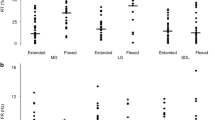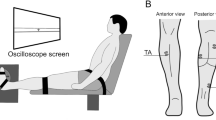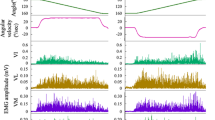Abstract
Force fluctuations during steady contractions of multiple agonist muscles may be influenced by the relative contribution of force by each muscle. The purpose of the study was to compare force fluctuations during steady contractions performed with the plantar flexor muscles in different knee positions. Nine men (25.8±5.1 years) performed steady contractions of the plantar flexor muscles in the knee-flexed and knee-extended (greater involvement of the gastrocnemii muscles) positions. The maximal voluntary contraction (MVC) force was 32% greater in the knee-extended position compared with the knee-flexed position. The target forces were 2.5–10% MVC force in the respective position. The amplitude of electromyogram in the medial gastrocnemius muscle was greater in the knee-extended position (10.50±9.80%) compared with the knee-flexed position (1.26±1.15%, P<0.01). The amplitude of electromyogram in the soleus muscle was not influenced by the knee position. The amplitude of electromyogram in the lateral gastrocnemius and tibialis anterior muscles was marginal and unaltered with knee position. At the same force (in Newtons), the standard deviation of force was lower in the knee-extended position compared with the knee-flexed position. These results indicate that force fluctuations during plantar flexion are attenuated with greater involvement of the medial gastrocnemius muscle.





Similar content being viewed by others
Abbreviations
- aEMG:
-
Root-mean-square amplitude of the electromyogram
- ANCOVA:
-
Analysis of covariance
- ANOVA:
-
Analysis of variance
- EMG:
-
Electromyogram
- EXT:
-
Knee-extended position
- FLX:
-
Knee-flexed position
- LG:
-
Lateral gastrocnemius
- MG:
-
Medial gastrocnemius
- MVC:
-
Maximal voluntary contraction
- SOL:
-
Soleus
- TA:
-
Tibialis anterior
References
Burnett RA, Laidlaw DH, Enoka RM (2000) Coactivation of the antagonist muscle does not covary with steadiness in old adults. J Appl Physiol 89:61–71
Cresswell AG, Löscher WN, Thorstensson A (1995) Influence of gastrocnemius muscle length on triceps surae torque development and electromyographic activity in man. Exp Brain Res 105:283–290
Fuglevand AJ, Winter DA, Patla AE (1993) Models of recruitment and rate coding organization in motor-unit pools. J Neurophysiol 70:2470–2488
Fugl-Meyer AR, Sjöström M, Wählby L (1979) Human plantar flexion strength and structure. Acta Physiol Scand 107:47–56
Fukunaga T, Roy RR, Shellock FG, Hodgson JA, Day MK, Lee PL, Kwong-Fu H, Edgerton VR (1992) Physiological cross-sectional area of human leg muscles based on magnetic resonance imaging. J Orthop Res 10:928–934
Galganski ME, Fuglevand AJ, Enoka RM (1993) Reduced control of motor output in a human hand muscle of elderly subjects during submaximal contractions. J Neurophysiol 69:2108–2115
Graves AE, Kornatz KW, Enoka RM (2000) Older adults use a unique strategy to lift inertial loads with the elbow flexor muscles. J Neurophysiol 83:2030–2039
Hamilton AF, Jones KE, Wolpert DM (2004) The scaling of motor noise with muscle strength and motor unit number in humans. Exp Brain Res 157:417–430
Hortobágyi T, Tunnel D, Moody J, Beam S, DeVita P (2001) Low- or high-intensity strength training partially restores impaired quadriceps force accuracy and steadiness in aged adults. J Gerontol A Biol Sci Med Sci 56:B38–B47
Jones KE, Hamilton AF, Wolpert DM (2002) Sources of signal-dependent noise during isometric force production. J Neurophysiol 88:1533–1544
Kawakami Y, Ichinose Y, Fukunaga T (1998) Architectural and functional features of human triceps surae muscles during contraction. J Appl Physiol 85:398–404
Kawakami Y, Kumagai K, Huijing PA, Hijikata T, Fukunaga T (2000) The length-force characteristics of human gastrocnemius and soleus muscle in vivo. In: Herzog W (ed) Skeletal muscle mechanics: from mechanisms to function. Wiley, Chichester, pp 327–341
Kennedy PM, Cresswell AG (2001) The effect of muscle length on motor-unit recruitment during isometric plantar flexion in humans. Exp Brain Res 137:58–64
Kornatz KW, Christou EA, Enoka RM (2005) Practice reduces motor unit discharge variability in a hand muscle and improves manual dexterity in old adults. J Appl Physiol 98:2072–2080
Kouzaki M, Shinohara M, Masani K, Fukunaga T (2004) Force fluctuations are modulated by alternate muscle activity of knee extensor synergists during low-level sustained contraction. J Appl Physiol 97:2121–2131
Laidlaw DH, Bilodeau M, Enoka RM (2000) Steadiness is reduced and motor unit discharge is more variable in old adults. Muscle Nerve 23:600–612
Latash ML, Scholz JF, Danion F, Schöner G (2002) Finger coordination during discrete and oscillatory force production tasks. Exp Brain Res 146:419–432
Li ZM, Latash ML, Zatsiorsky VM (1998) Force sharing among fingers as a model of the redundancy problem. Exp Brain Res 119:276–286
Loève M (1977) Probability theory I. Springer, Berlin Heidelberg New York
Maganaris CN (2003) Force-length characteristics of the in vivo human gastrocnemius muscle. Clin Anat 16:215–223
Moritz CT, Barry BK, Pascoe MA, Enoka RM (2005) Discharge rate variability influences the variation in force fluctuations across the working range of a hand muscle. J Neurophysiol 93:2449–2459
Murray MP, Guten GN, Baldwin JM, Gardner GM (1976) A comparison of plantar flexion torque with and without the triceps surae. Acta Orthop Scand 47:122–124
Nishimura Y, Nakajima Y (2002) Effect of muscle length on the recruitment property of single motor units in humans. Neurosci Lett 332:49–52
Sale D, Quinlan J, Marsh E, McComas AJ, Belanger AY (1982) Influence of joint position on ankle plantarflexion in humans. J Appl Physiol 52:1636–1642
Shinohara M, Li S, Kang N, Zatsiorsky VM, Latash ML (2003a) Effects of age and gender on finger coordination in MVC and submaximal force-matching tasks. J Appl Physiol 94:259–270
Shinohara M, Yoshitake Y, Kouzaki M, Fukuoka H, Fukunaga T (2003b) Strength training counteracts motor performance losses during bed rest. J Appl Physiol 95:1485–1492
Shinohara M, Scholz JP, Zatsiorsky VM, Latash ML (2004) Finger interaction during accurate multi-finger force production tasks in young and elderly persons. Exp Brain Res 156:282–292
Shinohara M, Keenan KG, Enoka RM (2005) Fluctuations in motor output during steady contractions are weakly related across contraction types and between hands. Muscle Nerve 31:741–750
Tamaki H, Kitada K, Akamine T, Sakou T, Kurata H (1997) Electromyogram patterns during plantarflexions at various angular velocities and knee angles in human triceps surae muscles. Eur J Appl Physiol Occup Physiol 75:1–6
Tamaki H, Kitada K, Akamine T, Murata F, Sakou T, Kurata H (1998) Alternate activity in the synergistic muscles during prolonged low-level contractions. J Appl Physiol 84:1943–1951
Taylor AM, Christou EA, Enoka RM (2003) Multiple features of motor-unit activity influence force fluctuations during isometric contractions. J Neurophysiol 90:1350–1361
Tracy BL, Enoka RM (2002) Older adults are less steady during submaximal isometric contractions with the knee extensor muscles. J Appl Physiol 92:1004–1012
Yoshitake Y, Shinohara M, Kouzaki M, Fukunaga T (2004) Fluctuations in plantar flexion force are reduced after prolonged tendon vibration. J Appl Physiol 97:2090–2097
Acknowledgments
This work was supported in part by Uehara Memorial Foundation Funding for Research. The authors acknowledge the assistance of Yoshimitsu Shinagawa with statistics, Evangelos Christou, Carol Mottram, and Kevin Keenan with comments on the manuscript, and Carolyn Barry with the preparation of the manuscript.
Author information
Authors and Affiliations
Corresponding author
Rights and permissions
About this article
Cite this article
Shinohara, M., Yoshitake, Y., Kouzaki, M. et al. The medial gastrocnemius muscle attenuates force fluctuations during plantar flexion. Exp Brain Res 169, 15–23 (2006). https://doi.org/10.1007/s00221-005-0119-6
Received:
Accepted:
Published:
Issue Date:
DOI: https://doi.org/10.1007/s00221-005-0119-6




